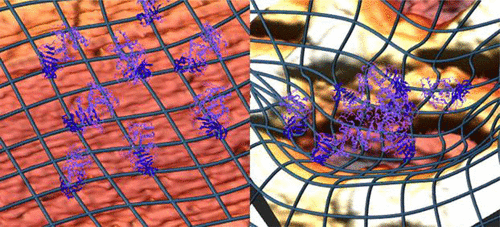当前位置:
X-MOL 学术
›
Cryst. Growth Des.
›
论文详情
Our official English website, www.x-mol.net, welcomes your feedback! (Note: you will need to create a separate account there.)
Hydrogel Composite Membranes Incorporating Iron Oxide Nanoparticles as Topographical Designers for Controlled Heteronucleation of Proteins
Crystal Growth & Design ( IF 3.8 ) Pub Date : 2018-05-07 00:00:00 , DOI: 10.1021/acs.cgd.7b01760 Shabnam Majidi Salehi 1, 2 , Ana C. Manjua 3 , Benny D. Belviso 4 , Carla A. M. Portugal 3 , Isabel M. Coelhoso 3 , Valentina Mirabelli 4 , Enrica Fontananova 1 , Rocco Caliandro 4 , João G. Crespo 3 , Efrem Curcio 2 , Gianluca Di Profio 1
Crystal Growth & Design ( IF 3.8 ) Pub Date : 2018-05-07 00:00:00 , DOI: 10.1021/acs.cgd.7b01760 Shabnam Majidi Salehi 1, 2 , Ana C. Manjua 3 , Benny D. Belviso 4 , Carla A. M. Portugal 3 , Isabel M. Coelhoso 3 , Valentina Mirabelli 4 , Enrica Fontananova 1 , Rocco Caliandro 4 , João G. Crespo 3 , Efrem Curcio 2 , Gianluca Di Profio 1
Affiliation

|
In this study, we exploited the possibility of tuning physical–chemical properties of hydrogel composite membranes (HCMs) surfaces, by using iron oxide nanoparticles (NPs) as topographical designers, with the aim of examining the effect of surface topography and wettability on the heterogeneous nucleation of protein crystals. On the basis of roughness and contact angle measurements, it was found that surface structural characteristics, in addition to chemical interactions between the surface and protein molecules, have influence on the heterogeneous nucleation of lysozyme and thermolysin crystals to different extents. We demonstrated that increasing the amount of NPs incorporated in the hydrogel matrix promotes protein nucleation to a higher extent, potentially due to the increase of local solute concentration, arising from the enhanced wetting tendency in the Wenzel regime, and physical confinement at rougher hydrophilic surfaces. An extensive crystallographic analysis suggested the tendency of the growing crystals to incorporate hydrogel materials, which allows inducement of protein conformational states slightly different from those covered by standard crystallization methods. Protein flexibility can be thus sampled by changing the amount of NPs in the HCMs, with negligible influence on the quantity and quality of X-ray diffraction data.
中文翻译:

掺入氧化铁纳米粒子的水凝胶复合膜,作为地形图设计者,用于蛋白质的控制性异核化
在这项研究中,我们利用氧化铁纳米颗粒(NPs)作为地形设计者,探索了调整水凝胶复合膜(HCMs)表面的物理化学性质的可能性,目的是检验表面地形和润湿性对异质性的影响蛋白晶体成核。根据粗糙度和接触角的测量,发现表面结构特征,除了表面和蛋白质分子之间的化学相互作用外,还在不同程度上影响溶菌酶和嗜热菌素晶体的异质成核。我们证明了增加水凝胶基质中NP的掺入量会在更大程度上促进蛋白质成核,这可能是由于局部溶质浓度的增加所致,这是由于Wenzel机制中的润湿趋势增强以及在较粗糙的亲水性表面上的物理限制所致。广泛的晶体学分析表明,正在生长的晶体倾向于掺入水凝胶材料,这使得诱导的蛋白质构象状态与标准结晶方法所涵盖的状态略有不同。因此,可以通过改变HCM中NP的数量来采样蛋白质的柔韧性,而对X射线衍射数据的数量和质量的影响可以忽略不计。这使得诱导的蛋白质构象状态与标准结晶方法所涵盖的状态略有不同。因此,可以通过改变HCM中NP的数量来采样蛋白质的柔韧性,而对X射线衍射数据的数量和质量的影响可以忽略不计。这使得诱导的蛋白质构象状态与标准结晶方法所涵盖的状态略有不同。因此,可以通过改变HCM中NP的数量来采样蛋白质的柔韧性,而对X射线衍射数据的数量和质量的影响可以忽略不计。
更新日期:2018-05-07
中文翻译:

掺入氧化铁纳米粒子的水凝胶复合膜,作为地形图设计者,用于蛋白质的控制性异核化
在这项研究中,我们利用氧化铁纳米颗粒(NPs)作为地形设计者,探索了调整水凝胶复合膜(HCMs)表面的物理化学性质的可能性,目的是检验表面地形和润湿性对异质性的影响蛋白晶体成核。根据粗糙度和接触角的测量,发现表面结构特征,除了表面和蛋白质分子之间的化学相互作用外,还在不同程度上影响溶菌酶和嗜热菌素晶体的异质成核。我们证明了增加水凝胶基质中NP的掺入量会在更大程度上促进蛋白质成核,这可能是由于局部溶质浓度的增加所致,这是由于Wenzel机制中的润湿趋势增强以及在较粗糙的亲水性表面上的物理限制所致。广泛的晶体学分析表明,正在生长的晶体倾向于掺入水凝胶材料,这使得诱导的蛋白质构象状态与标准结晶方法所涵盖的状态略有不同。因此,可以通过改变HCM中NP的数量来采样蛋白质的柔韧性,而对X射线衍射数据的数量和质量的影响可以忽略不计。这使得诱导的蛋白质构象状态与标准结晶方法所涵盖的状态略有不同。因此,可以通过改变HCM中NP的数量来采样蛋白质的柔韧性,而对X射线衍射数据的数量和质量的影响可以忽略不计。这使得诱导的蛋白质构象状态与标准结晶方法所涵盖的状态略有不同。因此,可以通过改变HCM中NP的数量来采样蛋白质的柔韧性,而对X射线衍射数据的数量和质量的影响可以忽略不计。



























 京公网安备 11010802027423号
京公网安备 11010802027423号